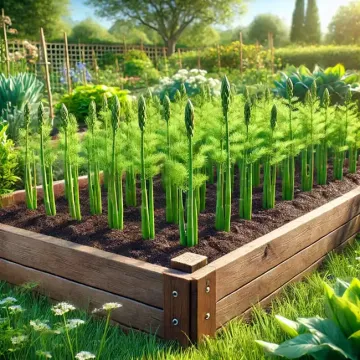Asparagus (Asparagus officinalis) is a perennial vegetable known for its long, tender spears and delicious taste. It is a hardy plant that can produce crops for 15 years or more with proper care, making it an ideal addition to a home garden. Although it requires patience—typically, you'll wait 2-3 years before your first harvest—the long-term benefits make it a rewarding choice.
History and Background
Asparagus has been cultivated for thousands of years, originating in the eastern Mediterranean and Near East regions. Ancient Egyptians valued it as a delicacy, and the Romans considered it a luxurious food item. The plant eventually made its way to Europe and then to the Americas, where it became a popular vegetable. Today, asparagus is grown worldwide, valued for its distinct flavor and health benefits.
Health Benefits
Asparagus is a powerhouse of nutrition, rich in vitamins A, C, E, and K, as well as folate, fiber, and antioxidants. It is known for its anti-inflammatory properties, supports digestive health, and may help reduce the risk of certain cancers. Additionally, asparagus is low in calories, making it a great choice for those seeking healthy, nutrient-dense food options.
Growing Asparagus in the Home Garden
Site Selection
Asparagus thrives in full sun and well-drained soil. Choose a location that receives at least 6-8 hours of sunlight daily. Since asparagus plants are perennial, ensure that the area you select won't need to be disturbed for years. Avoid low-lying spots that might collect water, as asparagus roots can rot in wet conditions.
Soil Preparation
Asparagus prefers soil that is rich in organic matter with a pH between 6.5 and 7.5. Before planting, work compost or well-rotted manure into the soil to ensure your asparagus beds are fertile. Raised beds are an excellent option for asparagus as they improve drainage, which is crucial for the plant’s success.
Planting Asparagus
Asparagus is typically planted from crowns (one-year-old root systems) rather than seeds for quicker production. Plant the crowns in early spring, as soon as the soil can be worked. Dig trenches about 12 inches wide and 6-8 inches deep. Place the crowns in the trench, spacing them 12-18 inches apart, and cover with 2 inches of soil. As the spears begin to grow, gradually fill in the trench with soil until it is level with the ground.
Watering and Mulching
Water asparagus regularly, especially during the growing season. It requires consistent moisture but not waterlogged conditions. Mulching with straw, grass clippings, or compost helps retain moisture, suppress weeds, and maintain a stable soil temperature. Asparagus is a heavy feeder, so consider adding a balanced fertilizer in early spring and after the harvest season.
Pests and Diseases
Asparagus is relatively pest-resistant, but common threats include asparagus beetles, cutworms, and aphids. Hand-picking beetles or using natural insecticidal soaps can help control these pests. To prevent fungal diseases like rust and root rot, ensure good air circulation around the plants and avoid overwatering.
Harvesting Asparagus
Patience is key when growing asparagus. During the first two years, allow the plants to establish strong root systems by resisting the temptation to harvest spears. In the third year, you can begin harvesting for about two weeks. As the plants mature, you can extend the harvest period to 6-8 weeks. Harvest spears when they are 6-8 inches tall by cutting them at ground level or just below the surface.
Post-Harvest Care
After the harvest season, allow the spears to grow into ferns, which will feed the roots for next year’s crop. The ferns should remain until they turn yellow and die back in the fall. At that point, cut them down to soil level and apply a thick layer of mulch for winter protection.
Popular Asparagus Varieties for the Home Garden
- Jersey Knight: This variety is known for its resistance to diseases and produces thick, high-yielding spears.
- Purple Passion: With a striking purple color, this variety offers a sweeter taste and is tenderer than green varieties.
- Mary Washington: A traditional heirloom variety, it’s widely grown for its reliability and vigorous growth.
Growing asparagus in your home garden requires patience and care, but the long-term rewards of fresh, tender spears year after year make it worthwhile. With proper planting, maintenance, and a little bit of effort, asparagus can be a perennial staple in your garden for many seasons to come.

